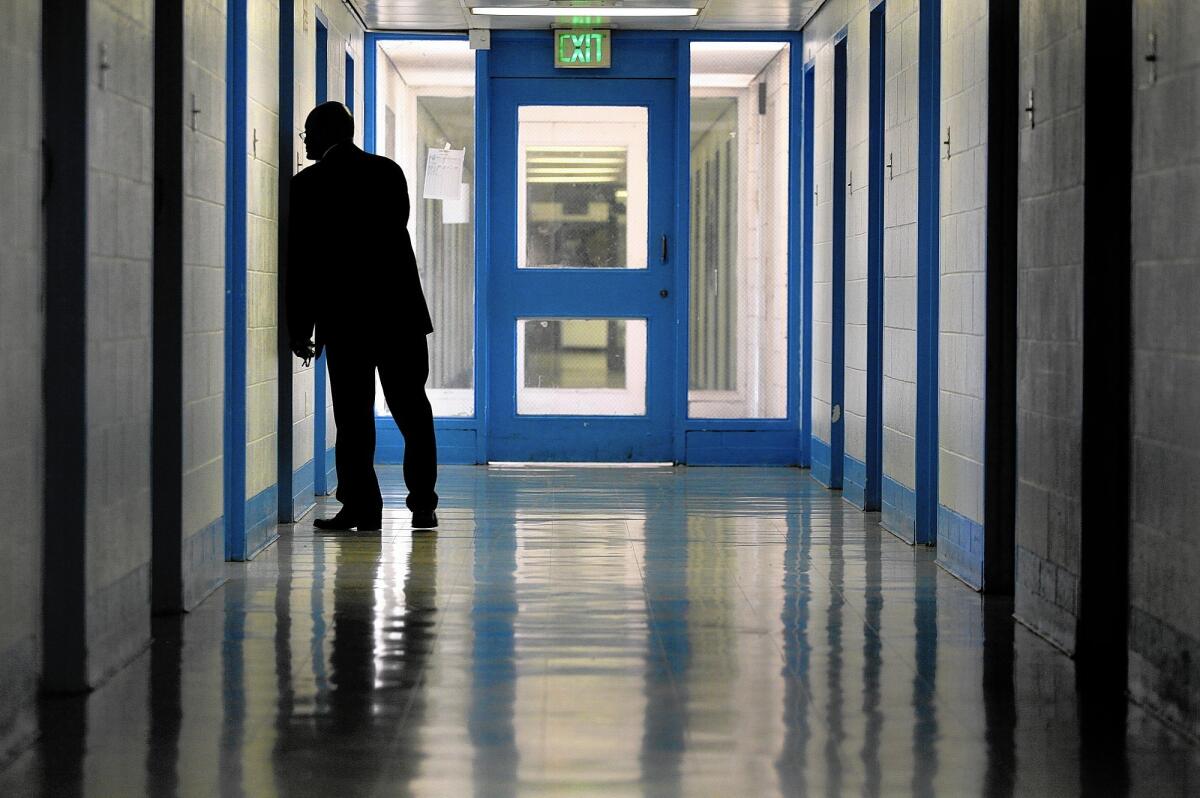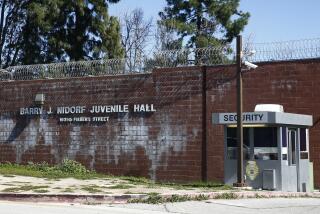L.A. County spends more than $233,000 a year to hold each youth in juvenile lockup

Supt. Gregory McCovey peers inside a room at Central Juvenile Hall in Los Angeles in 2014.
Los Angeles County’s juvenile detention system was designed in an era when youth crime was on the rise.
The number of juvenile arrests has fallen dramatically in recent years.
Some say the system has not kept up with this shift, and now it’s costing taxpayers money.
A county audit found that the average cost of incarcerating a youth has soared to $233,600 a year, significantly higher than other comparable jurisdictions. In Chicago, the annual cost was $204,400 per youth; in San Diego, it was $127,750; and in Houston, it was $84,680, the study said.
“There is so much waste,” said Jacqueline Caster, one of 15 members of the L.A. County Probation Commission. “And no one pays attention or cares.”
The high cost of incarcerating youths is generating debate both inside and outside county government and putting pressure on probation officials to address the problem.
Youth crime began dropping in the mid-1990s, as overall crime rates began declining in many U.S. cities.
At its height, the L.A. County Probation Department’s juvenile halls housed 2,000; last month, it was down to 621. Juvenile arrests have dropped 30% in L.A. County since 2012 alone, according to a Rand Corp. study.
Still, staffing has remained relatively steady, while the Los Angeles County Board of Supervisors has resisted closing the aging network of three juvenile halls and 18 camps or reducing the overall staff as the ratio of employees to incarcerated juveniles grows.
Cal Remington, who was appointed interim probation chief last month, is among those who see the situation as inefficient and untenable.
“We probably need to start considering closures,” he said.
In the camps, 535 children were detained in facilities built to hold 1,469, and the county continued to pay for the staffing and overhead costs for a capacity of 958.
Auditors noted that Los Angeles County costs are high partly because the Probation Department has been forced to spend money on improvements, such as additional mental health counseling, after a settlement in 2008 with the U.S. Justice Department, which determined that the camps and halls brutalized young detainees.
Salary and employee benefit increases also contributed to the surge, as have the department’s unusually high number of employees on leave for injuries ranging from assaults by detainees to falling out of chairs, auditors noted.
Join the conversation on Facebook >>
Two years ago, 15% of the workforce was either out or reassigned because of on-the-job injuries. Since then, the number of juvenile detention workers on leave has dropped to 6.2%.
Overall, however, the reasons for the high per-child price tag are still not well understood, the auditor’s report said.
Caster, the probation commissioner, said particular attention should be paid to labor costs. “We have all these union contracts and pension costs, and it is very hard to fire people,” she said. “I think you may find this is part of what is holding us back.”
Supervisor Hilda Solis said she supports an approach that focuses on results. “We need to invest in these kids. But we need to invest smartly, to make sure that public investments lead to the outcomes that we all want to see, which is to restore these children to productive and peaceful citizenship.”
Supervisor Sheila Kuehl said she had been unaware of the high costs and wouldn’t object to spending so much more taxpayer money on the camps and halls than other jurisdictions do if it helped to turn around troubled young people.
Noting the high cost of chronic poverty and incarceration, she said $233,000 a year could “be money well spent.”
Few juvenile justice researchers, however, would argue that the system — regardless of the amount spent on incarceration — does a great job of rehabilitating young people.
A recent study led by Cal State Los Angeles professor Denise Herz found that more than a third of the youth in county lockups were rearrested for new crimes and violations within a year of their release. Beyond that, a growing body of research indicates that someone who is incarcerated as a juvenile is at greater risk for future trouble than someone convicted of similar crimes but not locked up.
A study by economists Anna Aizer and Joseph Doyle Jr., for example, found that those incarcerated were 13% less likely to finish high school and 22% more likely to end up in prison as adults.
Nor is there evidence to suggest that the money L.A. spends on juvenile incarceration is used to keep up with capital improvements.
A 2014 report from the Los Angeles County civil grand jury documented leaking pipes, dry rot in support beams, decaying facades and peeling paint at the Eastlake Juvenile Hall.
“Bath towels and duct tape were used in a futile attempt to repair broken pipes and prevent seepage” in one housing unit, the grand jury reported after members inspected the hall. “There was an indistinct foul odor in the hallway suggesting that sewage or stagnant water was present.”
Meanwhile in Houston, where per-youth costs are lowest, conservatives and liberals are both cheering fewer resources for incarceration.
Fiscal hawks and left-leaning reformers combined there to push to pare facilities and funding for incarceration in favor of less-expensive community-based programs that focus on rehabilitation.
L.A. County officials were first made aware of the rising price tag for incarceration last year. The auditor report urged county Chief Executive Sachi Hamai to work with the Probation Department, which oversees the juvenile incarceration system, to gain a more complete understanding of why costs are skyrocketing and to develop solutions.
Six months later, Hamai’s office has developed no findings or recommendations, according to spokesman David Sommers, who denied a request to interview the analysts assigned to the review.
Twitter: @gtherolf
ALSO
Brother of Compton council member killed in East L.A. shooting
Orange County just launched its first clean-needle exchange
Former aide to West Hollywood councilman will receive $500,000 in lawsuit settlement
More to Read
Sign up for Essential California
The most important California stories and recommendations in your inbox every morning.
You may occasionally receive promotional content from the Los Angeles Times.











